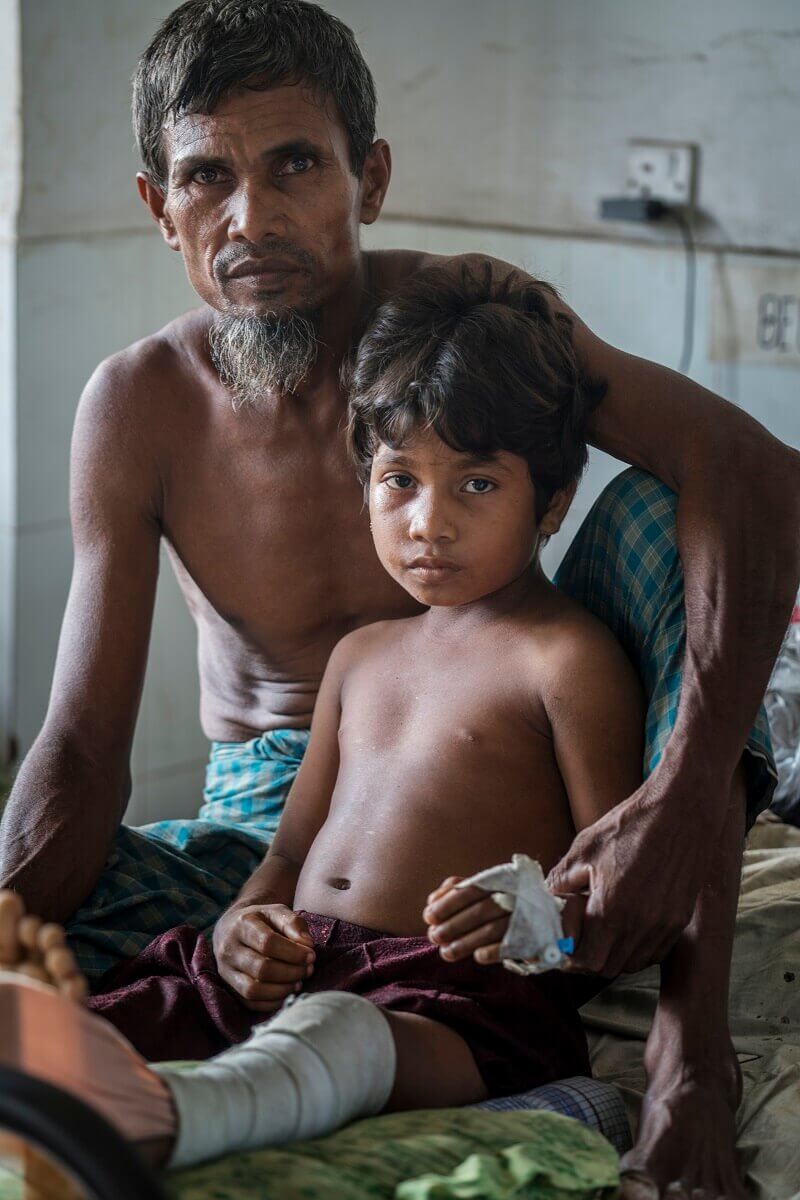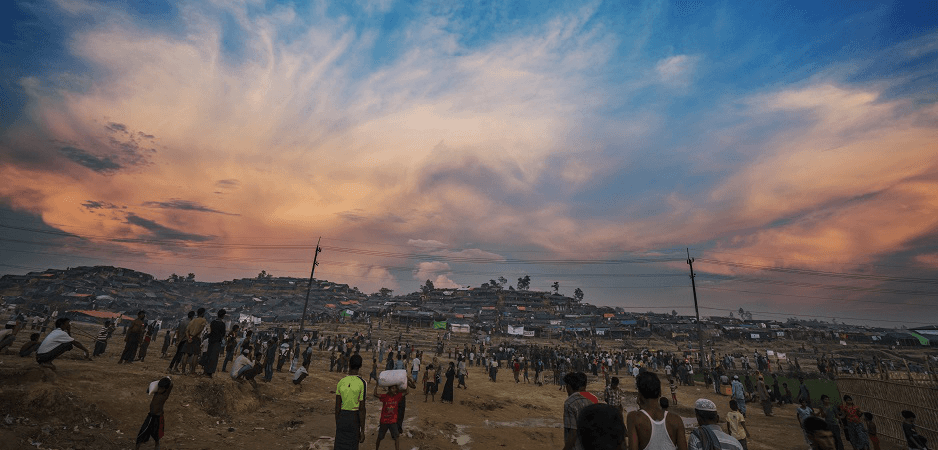There are close to a million Rohingya refugees in Bangladesh in desperate need of food, shelter and medical attention.
The flight of the Rohingya people is an exodus of unprecedented scale and speed. Since August, over 600,000 refugees have fled Rakhine State in Myanmar. Around 300,000 of them are children, 20,000 who are completely alone, orphaned by the brutality of the Myanmar military. Every refugee has been driven by violence, terror and the threat of death. Loved ones have been lost along the way, homes destroyed, funeral pyres made of entire villages. Many of the people we spoke to told the same stories — throats slit, bodies burned (sometimes alive), women raped, neither children nor the elderly spared, with men at highest risk of brutal summary execution.
We saw the smoke rising from the burning villages near the Myanmar-Bangladesh border. Bangladeshi locals told us they see about 20 such fires every day. I was accompanied by a remarkable photographer and campaigner, Shahidul Alam, with whom we had worked over many years on different and challenging issues — the stigma of HIV/AIDS, the impact of the 2005 Pakistan earthquake. I recently met up with him in London, and he shared with me his anger and anguish about the Rohingya who have found refuge in his country, Bangladesh. In his determination to focus attention on their suffering, to drive change and build support for these persecuted people in their exodus of pain, he asked if I would go with him and help in any way possible. I volunteered immediately, knowing that his understanding of the context in Bangladesh and his commitment to challenging injustice would bring a special energy and focus, and that I would learn so much from him because we would be moving in very different circles to those I had experienced working with established international charities.
Through Shahidul I met a young journalist from Myanmar, who cannot be named for his protection. He explained that when land is burned, it reverts to government ownership, so it is no accident that torching is the favored method of destruction in Rakhine State, where valuable minerals are ready for exploitation once the farmers have been scorched off their land, murdered or banished. The journalist also gave an explanation for the acceptance by so many people in Myanmar of the longstanding cruelty and discrimination inflicted on the Rohingya, with decades of dictatorship having blunted critical thinking and years of sanctions having poisoned trust in Western media. The people of Myanmar have become easy prey for propaganda by those in power, who still comprise many of the military figures from the darks days of the dictatorship, including some of the closest advisors at the highest level of Aung San Suu Kyi’s government.
The consequences of this have been dire. In their flight, the Rohingya are leaving behind all they know and love. At the Balukhali camp in Cox’s Bazar, a young woman said to me: “I did not want to leave my home to come here. I had two cows and land, and now I have nothing.” Looking at the rain-soaked bare earth, seeing her shivering, emaciated children, the prospect of returning to a life where she could milk her cows and tend to her crops seemed a distant dream.
The Lost Children
Walking through the sparkling green paddy fields near Teknaf, a small town on the river Naf that borders Myanmar, the calm swishing of the boats rowing downstream ushers in an awareness of the scale of what these Rohingya had lost and left behind: homes, rivers to fish, fields to plough, animals to tend, space for children to play, and the friendship and comfort of families and neighbors. Standing atop an old Bangladeshi army watchtower, overlooking the burning villages across the water, no more than half a mile away, looking backward at the simple but peaceful villages of Cox’s Bazar, you have a vivid sense of their past and their painful present — hungry, dislocated and alone, families separated in the flight or murdered before they escaped, villages broken up and social life destroyed. The most painful of all is to see the lost and frightened children in the camps. Even those who have not been orphaned or lost, they no longer have their smiles.
I saw a child of about age 3 piteously crying for his mother. I saw a mother crying for her lost children. Were they connected? Was the lost child hers? Perhaps. Perhaps not. The toddler had already disappeared into the chaos, and the woman was still looking for her children. Thankfully, Handicap International and other charities have set up projects to reunite loved ones — an immense job in the vast, overcrowded camps.
Later at the Sadar Hospital in Cox’s Bazar, we met a woman named Senowara Begum. She had been shot three times and deeply traumatized by the loss of two of her three children, adding intolerable grief to the pain of her wounds.
At Tefnar, we met Abdul Basar, struggling with clumsy adult wooden crutches, his leg amputated after severe burns. His father was also injured and in a hospital far away, his mother dead and his cousin Abdul Basar — just an inch taller and a year older — was the only person to care for him as he struggled to walk, his delicate face pinched with pain and anxiety.
Trauma Trap
The logistical challenges of the makeshift camps are overwhelming. The tarpaulins have been hastily fixed to bamboo poles, the trees torn from the hills to make space, narrow, winding steps hacked into the sandy soil. Water flows over latrines, spreading the stench of sewage everywhere and with it the fatal risk of cholera, with other diseases like measles and polio waiting in the wings. There is a risk of a major setback to the advances fought so hard for in Bangladesh, which has managed to eradicate polio despite extreme poverty but is now facing the prospect of it returning with more pain and maiming. The lack of clean water, pollution and the urgent need for medical care and food is frightening. Even the most experienced aid workers have said that this is the worst refugee crisis they have ever seen.

© Shahidul Alam
After the flight to safety other terrors await: the risk of hunger, trafficking, loneliness, loss and death. Some of the sickest and most traumatically injured have managed to get to the hospital. The Sadar District Hospital in Cox’s Bazar is overcrowded and short on both staff and medicine. The heroic health workers are doing their best to help. The resident medical officer, Dr. Shaheen Chowdury, has immaculate records of the injured and sick: gunshot wounds, burns, pneumonia, near drowning, obstructed labor. The hard journey and the camp conditions have taken their toll on the weakest and the most vulnerable.
Narshida, a lively young girl, no more than 10 years old, was smiling at us, glad of a break from her sad task of caring for her handsome young father as he lay immobile on a mattress on the floor, too weak to respond to his daughter’s loving ministrations. As we left, she was carefully stroking his forehead. Fatima was cradling her tiny baby, delicately trying to encourage her little girl to eat. She had traveled for 20 days, and the journey had taken a terrible toll on her child’s health.
Another father held his daughter, Nurkajol, who is only 9, in his arms, her broken leg immobilized, weighted by a simple plastic bottle filled with water to help the healing and prevent the pain. But on her face agony was vivid and present, her eyes listless, her limbs so thin and the trauma of her experience at the hands of the military an unwelcome and constant companion. Her father explained that when the military came and attacked their village, in the panic they lost Nurkajol. Then, before fleeing across the border, they crept back into the village and found her alone, a frail little girl that the military had beaten with their rifle butts.
The life force and curiosity of these children shines through the pain of their exile. In northern Rakhine State they suffered severe discrimination, having access to only the most minimal education, but right now there are thousands of children in these camps across Bangladesh with even fewer opportunities. Amidst the pressure of so many people and so many children, schooling has not yet been given priority. Education must be properly provided to help these children survive and thrive. In the chaos of the camps this is a challenge, with so much else needing to be done. But these children are the future, and education can provide a way out of the trap of trauma.
Well-Meaning, Ill-Advised
The government of Bangladesh has brought some order to the camps that have spontaneously sprung up, housing over 800,000 Rohingya. Longer-term plans being discussed by the government have suggested moving refugees off the hills to build a proper camp, but this presents a major logistical challenge. The Bangladeshi government and nongovernmental organizations are doing their best with the problematic geography of an unstable hilly environment, which makes it difficult to move people or services effectively and also makes the job of water engineers designing latrines and wells difficult.
The Bangladeshi military is also organizing and building basic infrastructure and doing crowd control, which is badly needed when so many frightened people are trapped together in cramped conditions. Local and international organizations desperately need to scale up the relief effort, but the government needs to be assured that the organizations coming in are the right ones for the job.
Bangladeshi charities such as Brac are significant players, with a local and international presence, and other local charities are providing important services, including specialist help for those who have become overwhelmed by trauma. The clinical psychologists I met at a mental health service center run by Gonoshasthaya Kendra, a local medical charity working in partnership with Médecins du Monde, said they believed everybody in the camp was traumatized. But they were only able to treat the very worst affected, like the young girl lying outside the tent clinic who had been rendered speechless by the violence she had witnessed and, in her torment, was violently attacking her own mother. She is only one of the endless thousands in need of mental-health assistance.
The United Kingdom has the advantage of the Disasters Emergency Committee that, when it comes to crises of this scale, enables a unified approach to raising funds and support by coordinating major charities like Oxfam, Care International, Concern, ActionAid, Islamic Relief and half a dozen other experienced organizations. Doctors Without Borders has set up clinics, and UN agencies are also on the ground in Bangladesh, but it still is not enough when the continuing exodus of pain is driving tens of thousands of new refugees every day into the already seriously overcrowded camps.
The logistics and transport links are a challenge. Well-meaning but ill-advised attempts to contribute have not helped: When we were there, the Rohingya were busy trying to clear endless piles of muddy and useless clothing that have been tossed out of the windows of passing cars by well-intentioned local people. A trampled sweater in the mud was a sad sign that expert help is needed, not woollen clothes in the brutal heat of the Asian summer.
The Rohingya have suffered decades of discrimination and stigma and have endured so much on their tortuous journey to safety. Just the other day I heard from the talented Bangladeshi photojournalist, Mohammad Shahnewaz Khan, who worked with us in Cox’s Bazar, that he had been back to the border and was devastated to see that new refugees escaping the brutality in Myanmar were being prevented from entering Bangladesh. It is the duty of the international community, governments, national and international charities and all of us as citizens of the world to put our best efforts into helping the Rohingya and to raise our voices wherever we are to defend their right to return to their lost lives, lands and to a better future.
*[For more of Shahidul Alam’s work, visit www.shahidulnews.com. This article was updated on November 15, 2017, at 23:00 GMT.]
The views expressed in this article are the author’s own and do not necessarily reflect Fair Observer’s editorial policy.
Photo Credit: Shahidul Alam
Support Fair Observer
We rely on your support for our independence, diversity and quality.
For more than 10 years, Fair Observer has been free, fair and independent. No billionaire owns us, no advertisers control us. We are a reader-supported nonprofit. Unlike many other publications, we keep our content free for readers regardless of where they live or whether they can afford to pay. We have no paywalls and no ads.
In the post-truth era of fake news, echo chambers and filter bubbles, we publish a plurality of perspectives from around the world. Anyone can publish with us, but everyone goes through a rigorous editorial process. So, you get fact-checked, well-reasoned content instead of noise.
We publish 2,500+ voices from 90+ countries. We also conduct education and training programs
on subjects ranging from digital media and journalism to writing and critical thinking. This
doesn’t come cheap. Servers, editors, trainers and web developers cost
money.
Please consider supporting us on a regular basis as a recurring donor or a
sustaining member.
Will you support FO’s journalism?
We rely on your support for our independence, diversity and quality.







